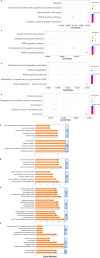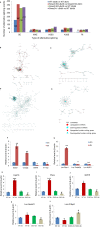Identification of Smad3-related transcriptomes in type-2 diabetic nephropathy by whole transcriptome RNA sequencing
- PMID: 33369170
- PMCID: PMC7882931
- DOI: 10.1111/jcmm.16133
Identification of Smad3-related transcriptomes in type-2 diabetic nephropathy by whole transcriptome RNA sequencing
Abstract
Smad3 deficiency prevents the development of type 2 diabetic nephropathy; however, the underlying molecular mechanisms remain unknown. In this study, we aimed to identify Smad3-related genes involved in the pathogenesis of diabetic kidney disease. High-throughput RNA sequencing was performed to profile the whole transcriptome in the diabetic kidney of Smad3 WT-db/db, Smad3 KO-db/db, Smad3+/- db/db and their littermate control db/m mice at 20 weeks. The gene ontology, pathways and alternative splicing of differentially expressed protein-coding genes and long non-coding RNAs related to Smad3 in diabetic kidney were analysed. Compared to Smad3 WT-db/db mice, Smad3 KO-db/db mice exhibited an alteration of genes associated with RNA splicing and metabolism, whereas heterozygosity deletion of Smad3 (Smad3+/- db/db mice) significantly altered genes related to cell division and cell cycle. Notably, three protein-coding genes (Upk1b, Psca and Gdf15) and two lncRNAs (NONMMUG023520.2 and NONMMUG032975.2) were identified to be Smad3-dependent and to be associated with the development of diabetic nephropathy. By using whole transcriptome RNA sequencing, we identified novel Smad3 transcripts related to the development of diabetic nephropathy. Thus, targeting these transcripts may represent a novel and effective therapy for diabetic nephropathy.
Keywords: Smad3 deficiency; alternative splicing; diabetic kidney disease; whole transcriptome.
© 2020 The Authors. Journal of Cellular and Molecular Medicine published by Foundation for Cellular and Molecular Medicine and John Wiley & Sons Ltd.
Conflict of interest statement
No potential conflicts of interest relevant to this article were reported.
Figures




Similar articles
-
Deletion of Smad3 prevents renal fibrosis and inflammation in type 2 diabetic nephropathy.Metabolism. 2020 Feb;103:154013. doi: 10.1016/j.metabol.2019.154013. Epub 2019 Nov 15. Metabolism. 2020. PMID: 31734275
-
Identification of Genes Associated with Smad3-dependent Renal Injury by RNA-seq-based Transcriptome Analysis.Sci Rep. 2015 Dec 9;5:17901. doi: 10.1038/srep17901. Sci Rep. 2015. PMID: 26648110 Free PMC article.
-
Whole transcriptome analysis of diabetic nephropathy in the db/db mouse model of type 2 diabetes.J Cell Biochem. 2019 Oct;120(10):17520-17533. doi: 10.1002/jcb.29016. Epub 2019 May 20. J Cell Biochem. 2019. PMID: 31106482
-
The pathogenesis of diabetic nephropathy: focus on microRNAs and proteomics.J Nephrol. 2013 Sep-Oct;26(5):811-20. doi: 10.5301/jn.5000262. Epub 2013 Mar 27. J Nephrol. 2013. PMID: 23543479 Review.
-
Recent insights into diabetic renal injury from the db/db mouse model of type 2 diabetic nephropathy.Am J Physiol Renal Physiol. 2011 Feb;300(2):F301-10. doi: 10.1152/ajprenal.00607.2010. Epub 2010 Dec 8. Am J Physiol Renal Physiol. 2011. PMID: 21147843 Review.
Cited by
-
The role of lncRNAs in regulation of DKD and diabetes-related cancer.Front Oncol. 2022 Oct 13;12:1035487. doi: 10.3389/fonc.2022.1035487. eCollection 2022. Front Oncol. 2022. PMID: 36313695 Free PMC article. Review.
-
TGF-Beta as a Master Regulator of Diabetic Nephropathy.Int J Mol Sci. 2021 Jul 23;22(15):7881. doi: 10.3390/ijms22157881. Int J Mol Sci. 2021. PMID: 34360646 Free PMC article. Review.
-
Circ_0054633 silencing suppresses hyperglycemia-induced extracellular matrix accumulation in renal mesangial cells by regulating MiR-136-5p/SMAD3 signaling.Noncoding RNA Res. 2025 May 6;13:84-93. doi: 10.1016/j.ncrna.2025.05.003. eCollection 2025 Aug. Noncoding RNA Res. 2025. PMID: 40476021 Free PMC article.
-
Neat1 promotes acute kidney injury to chronic kidney disease by facilitating tubular epithelial cells apoptosis via sequestering miR-129-5p.Mol Ther. 2022 Oct 5;30(10):3313-3332. doi: 10.1016/j.ymthe.2022.05.019. Epub 2022 May 26. Mol Ther. 2022. PMID: 35619557 Free PMC article.
-
Therapeutic potential for renal fibrosis by targeting Smad3-dependent noncoding RNAs.Mol Ther. 2024 Feb 7;32(2):313-324. doi: 10.1016/j.ymthe.2023.12.009. Epub 2023 Dec 12. Mol Ther. 2024. PMID: 38093516 Free PMC article. Review.
References
-
- Zhang L, Long J, Jiang W, et al. Trends in chronic kidney disease in China. N Engl J Med. 2016;375:905‐906. - PubMed
-
- Wen L, Zhang Z, Peng R, et al. Whole transcriptome analysis of diabetic nephropathy in the db/db mouse model of type 2 diabetes. J Cell Biochem. 2019;120:17520‐17533. - PubMed
-
- Hameed I, Masoodi SR, Malik PA, et al. Genetic variations in key inflammatory cytokines exacerbates the risk of diabetic nephropathy by influencing the gene expression. Gene. 2018;661:51‐59. - PubMed
Publication types
MeSH terms
Substances
Grants and funding
- 2016YFC0906101/National Key R&D Program of China
- 201704020167/Guangzhou Municipal Programme of Science and Technology
- Lui Che Woo Institute of Innovative Medicine
- 2020A1515010247/Guangdong Basic and Applied Basic Research Foundation
- 201806010123/Guangzhou Science, Technology and Innovation Commission
- HMRF 05161326/the Health and Medical Research Fund of Hong Kong
- 06173986/the Health and Medical Research Fund of Hong Kong
- 14152321/the Health and Medical Research Fund of Hong Kong
- 2017A050503003/Guangdong Provincial Programme of Science and Technology
- 2017B020227006/Guangdong Provincial Programme of Science and Technology
- 2019B121205005/the Guangdong-Hong Kong-Macao-Joint Labs Program from Guangdong Science and Technology
- 2017B030314019/Operational Grant of Guangdong Provincial Key Laboratory
- Y50179/Kelin Young Talents Program of the First Affiliated Hospital of Sun Yat-sen University
- C7018-16G/the Research Grants Council of Hong Kong
- GRF 14163317/the Research Grants Council of Hong Kong
- 14117418/the Research Grants Council of Hong Kong
- 14104019/the Research Grants Council of Hong Kong
- R4012-18/the Research Grants Council of Hong Kong
LinkOut - more resources
Full Text Sources
Medical
Molecular Biology Databases
Research Materials
Miscellaneous

